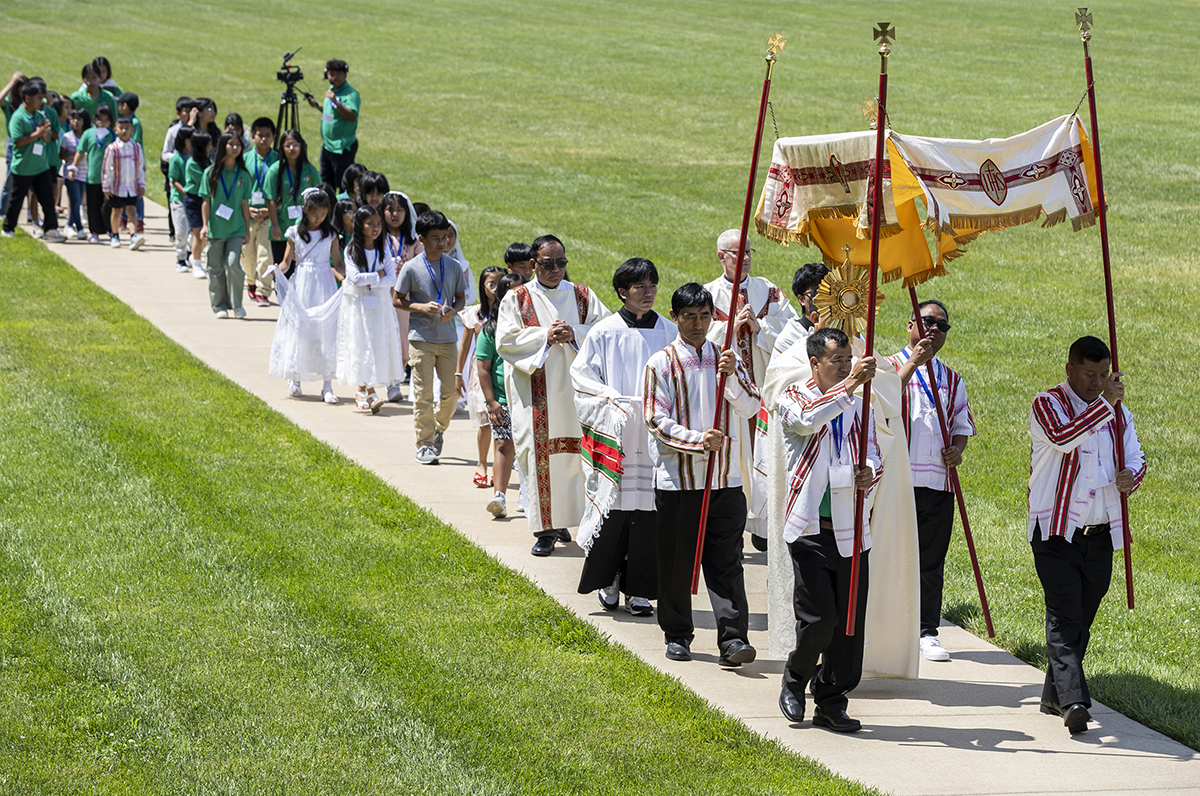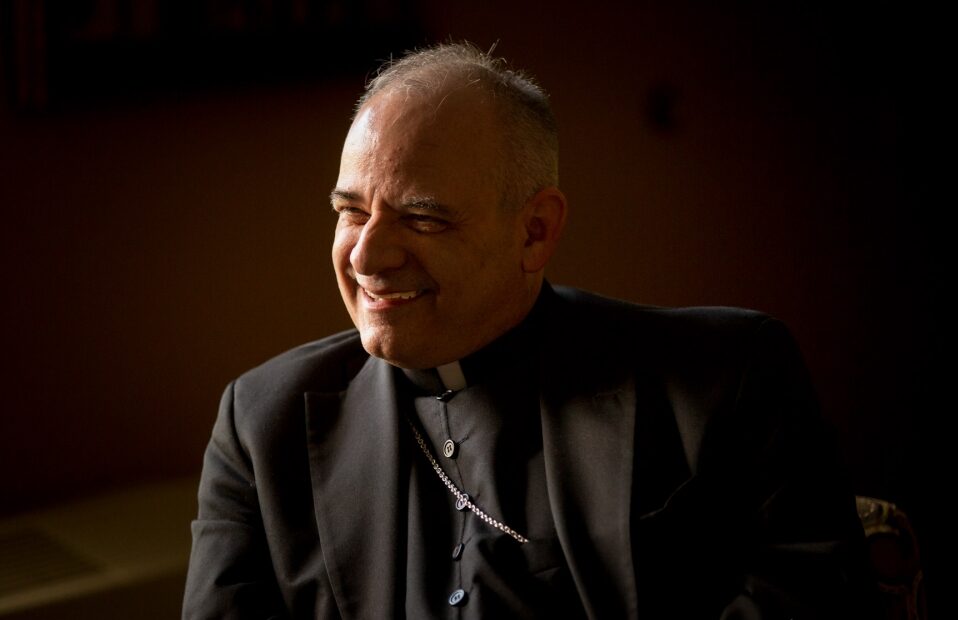Catholic value of discovery motivates SLU research

Saint Louis University aims to be top Catholic, Jesuit research university
In a sorghum field in Arizona, a scanner with cameras and sensors passes over various lines, cultivars and hybrids of the plants capturing data in granular detail. The research seeks to determine heat tolerance and water stress from each type of the plant.
The partnership with the Donald Danforth Plant Science Center, other universities and the U.S. Energy Department — with a goal of developing bioenergy from sorghum better able to withstand the droughts and rising temperatures expected with climate change — is just one example of research at Saint Louis University’s Remote Sensing Lab, part of its Department of Earth and Atmospheric Sciences.
Saint Louis University aims to become the world’s leading Catholic, Jesuit research university, according to Ken Oliff, vice president for research at SLU.
It should be no surprise, he said, since discovery of truth and knowledge is part of the Catholic intellectual tradition.
The growth in research — a five-year growth plan was launched in the fall of 2017 — is important to the future of the university and for its work in the St. Louis community, Oliff said. “It’s a major piece of where the university is going.”
SLU’s investment and prioritization of research affects topics of vital concern for Catholics, he noted. One example is research into opioid addiction and treatment. Faculty across the university who study biology, sociology, public health and epidemiology are working together to pool their knowledge to make a difference in addressing the opioid crisis that has affected the lives of millions of Americans. In 2017, there were 951 opioid deaths in Missouri. The Missouri Department of Health and Senior Services calls it the number one public health issue in the state.
Research also is being conducted by faculty for vaccines to counter diseases that affect people in less-developed countries as well as improved vaccines that help people closer to home such as a universal flu vaccine especiall to protect the very young and very old populations.
Father Chris Collins, assistant to the president for mission and identity at SLU, said the university’s three core functions are teaching, research and service. “For the teaching to be continually relevant it also requires discovery of new knowledge,” Father Collins said. “A great university serves the common good. We’re trying to improve the world in different ways.”
Research brings discovery about creation and the human condition, which fits with the mission of a Catholic university, he added. In the early days of the Society of Jesus, he said, the Jesuits went out to new parts of the world and discovered plants, animal species and more. The study of astronomy grew from that as well. “It’s part of the Jesuit tradition,” Father Collins said.
Earlier last year, SLU challenged its faculty and students to compete in a multi-year competition called The Big Ideas Challenge offering increasing levels of investment for projects that showcase broad faculty engagement, strong leadership and compelling research initiatives.
Nearly 40 proposals were submitted by teams composed of SLU faculty and students. SLU has awarded $500,000 in grants to 12 projects.
“The need for an ethical approach to research could not be more important, both as a model for the university we are and aspire to be, but also as a distinctive contribution that we as a Jesuit university make,” said Oliff, who was appointed to his position in July 2016. “Our ethical reflection on these issues is a key piece of what we bring.”
He cited the area of geospatial intelligence, which can have positive effects such as monitoring disease outbreaks in underdeveloped countries. But it involves ethical issues of privacy and safety concerns.
“The ethics and morality of geospatial, where you have the ability to monitor many, many things that previously were not monitored, becomes a core thing SLU brings to the table,” Oliff said. “As science and technology advances, our ability to build and use tools goes faster than our reflection on whether we should be using those tools or how we should use those tools.”
Oliff said universities have an additional capacity to solve problems, train leaders and address the world’s problems. SLU is seeking to bring together the best minds in the world to take on complex challenges, he said. Universities tend to chop knowledge up into pieces, and it becomes difficult to pull together the expertise from throughout the university, he noted. “One of the things we can do as a Catholic, Jesuit university is to take a holistic approach,” he said, citing the problem with opioids and how areas throughout the university are mobilized to tackle “this incredibly important social issue. Our job is creation of knowledge for the service of humanity.”
>> Research
Research is important to Saint Louis University because it:
• Is key to the university’s future
• Builds on the pledge to be a leading Catholic, Jesuit research university
• Affects topics that matter to people and is part of the Church’s mission
Informed by the university’s Jesuit mission, SLU researchers are motivated by a concern for the most vulnerable members of our society. One current area of research, for example, involves incarceration and the rehabilitation of inmates since SLU already has an outreach in jail and prison ministry and assisting with the re-entry of released inmates.
Ken Oliff, vice president of research at SLU, seeks the support of the Catholic community in St. Louis. “St. Louis needs two great research universities,” he said, referencing SLU and Washington University. “This is SLU’s time.”
>> SLU Research Institute
• Advances Saint Louis University’s existing research ambitions to grow scholarship and research.
• Created with a $50 million donation from Jeanne and Rex Sinquefield. The gift was the largest in SLU’s 200-year history.
• Will serve as the focal point for SLU’s strategic goal of growing the scale and eminence of its research and scholarship. It will also establish a new Sinquefield Center for Applied Economic Research and provide annual support to SLU’s chess team.
• The University will recruit and retain faculty research leaders who have a strong track record and potential for future funding and provide accompanying investments to support them. Among other efforts, SLU will create research institute fellowships for early, mid-career and highly accomplished senior faculty.
• Faculty will be encouraged to propose multi-disciplinary research programs that build upon SLU’s existing strengths and have the potential to achieve significant impact. Projects that engage undergraduate students as collaborators will be encouraged.
• The institute will fund the acquisition of additional resources, such as instrumentation, equipment and technology, that are critical to conducting and advancing leading-edge research. A portion of the growth fund will be designated to promoting research experiences for undergraduate students, including opportunities for ambitious capstone projects.
>> Remote Sensing Lab
Drones, cameras and high-end computing — they’re all a part of the Remote Sensing Lab in the Department of Earth and Atmospheric Sciences at St. Louis University, led by Vasit Sagan.
Researchers using geospatial tools focus on food, water and energy needs. Multi-scale remote sensing tools are used for improved crop productivity, for example.
Climate change has a significant effect on crop yields, Sagan said. Images from drones and satellites look at water availability or may get a picture of large fields to provide detail that’s difficult or impossible to see otherwise, he added.
In another area, heat maps are used in disease identification/outbreaks when sensors detect fevers.
In St. Louis, a project is helping Bellefontaine Cemetery track the health of its trees and detect invasive species of plants. Another effort assists with spotting potential areas of power failure in storms. At Cahokia Mounds in Illinois, drones are used to help understand prehistoric settlements.






